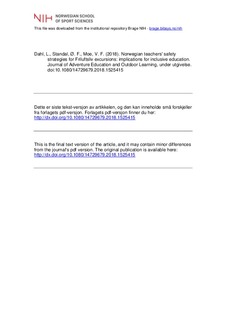Norwegian teachers' safety strategies for Friluftsliv excursions: implications for inclusive education
Peer reviewed, Journal article
Published version
Permanent lenke
http://hdl.handle.net/11250/2642660Utgivelsesdato
2018Metadata
Vis full innførselSamlinger
Originalversjon
Journal of Adventure Education and Outdoor Learning. 2018, . 10.1080/14729679.2018.1525415Sammendrag
The purpose of this study was to explore how teachers in friluftsliv (the Scandinavian equivalent of outdoor education and outdoor recreation) reflect upon their safety strategies in relation to pupils’ friluftsliv abilities in the upper secondary school ‘Sport and Physical Education programme’. This article is based on six focus group interviews of friluftsliv teachers. The analysis of the empirical material is inspired by John Evans’s understanding of the concept of abilities as dynamic sociocultural constructs and processes. In the findings, different challenges related to teachers’ experiences of a general decline in pupils’ winter friluftsliv abilities are identified. Furthermore, the article identifies and discusses challenges related to teachers’ safety strategies, which led to both inclusion and exclusion of pupils. The findings in this study reveal a tension between important winter outdoor skills and inclusive friluftsliv Norwegian teachers' safety strategies for Friluftsliv excursions: implications for inclusive education
Beskrivelse
The article has been peer-reviewed, but does not include the publisher’s layout, page numbers and proof-corrections. Citation for the published paper: Dahl, L. F., Moe, V., & Standal, O. (2018). Norwegian teachers’ safety strategies for Friluftsliv excursions: Implications for inclusive education. Journal of Adventure Education and Outdoor Learning, 1-13. https://doi.org/10.1080/14729679.2018.1525415
